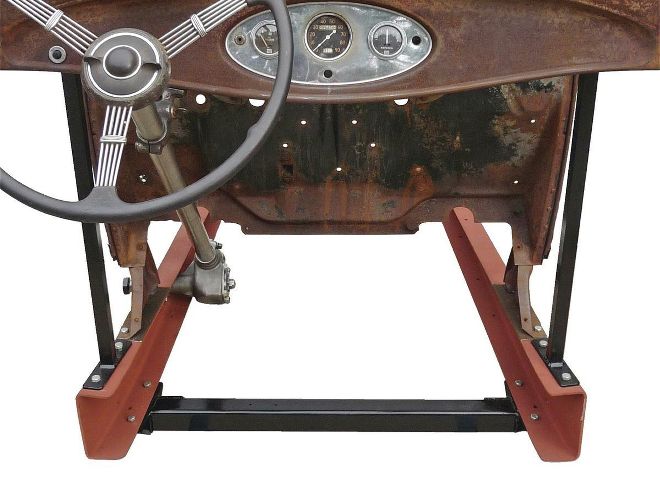
Hot rodding has always been about improving a vehicle’s performance. As a result, hopping up an engine for more horsepower was a regular topic in the early hobbyist magazines but other issues were also addressed, such as improving the steering in ’32-34 Fords.
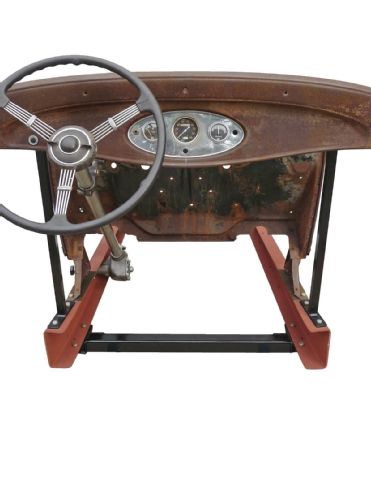 Neal Jennings converted a ’37 Hudson steering gear for use in Geoff Skene’s ’32 Ford. Note the stock light switch in the center of the banjo steering wheel.
Neal Jennings converted a ’37 Hudson steering gear for use in Geoff Skene’s ’32 Ford. Note the stock light switch in the center of the banjo steering wheel.
Like most low-priced cars of the day, Ford used worm and sector steering. Basically the steering wheel turned a threaded shaft, or the worm, that engaged threads on a shaft, or the sector, that the Pitman arm attached to. Turning the steering wheel was like turning a screw in a nut, turn the wheel one way and the sector moved the Pitman arm and the car turned left, turn the shaft the other way and the car went right. Simple enough, but friction between the worm and sector could make steering difficult.
Another type of steering used in more expensive cars of the period was worm and roller. In this design the worm gear engages a spinning roller on the sector shaft, the advantages are reduced steering effort and less wear on the components. One of the cars of the period equipped with worm and roller steering was the ’37 Hudson and that steering gear was the subject of a number of installation stories in ’32-34 Fords in various early rodding magazines.
At this point we should point out an interesting feature to those unfamiliar with original Fords, from 1928-39 the knob for the headlights, high and low beam, was in the center of the steering wheel, along with the horn button. The actual switch was mounted on the bottom of the steering gear and was activated by a rod that ran from the knob through the center of the steering shaft. We’ll show why this is relevant shortly.
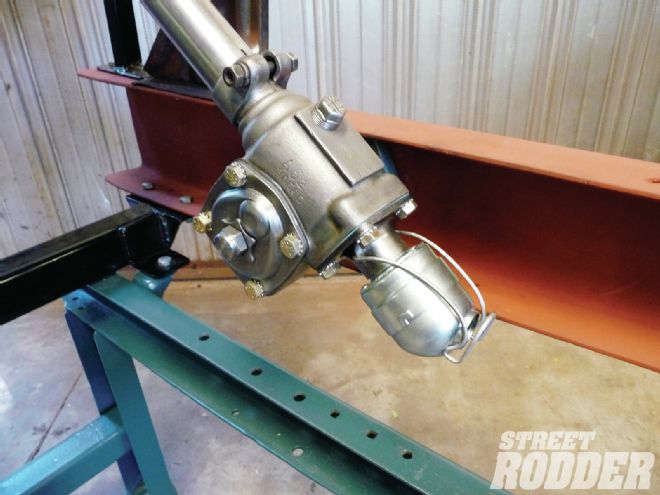 The modified Hudson steering gear looks right at home in the ’32 ’rails. That’s the headlight switch at the end of the box.
The modified Hudson steering gear looks right at home in the ’32 ’rails. That’s the headlight switch at the end of the box.
Geoff Skene is no stranger to hot rods with old-school style. His Flathead-powered ’32 out of the Ionia Hot Rod Shop graced our cover in the July ‘07 issue. We crossed paths with Skene this summer (at Brennan’s chocolate doughnut intervention in the Tetons, but that’s another story) and while discussing our favorite subject (hot rods) he told us of a Hudson steering conversion being done by Neal Jennings. At his point we’ll let Jennings elaborate:
“A few years ago, I found myself searching for a solution to a steering column angle problem in my roadster pickup. I had planned on F-1 steering gear but found it would make the steering column angle too steep and even with a long column drop the steering wheel was too close to the laid-back windshield. As I was intent on using a 17-inch Lincoln Zephyr steering wheel, a smaller wheel was not an option.
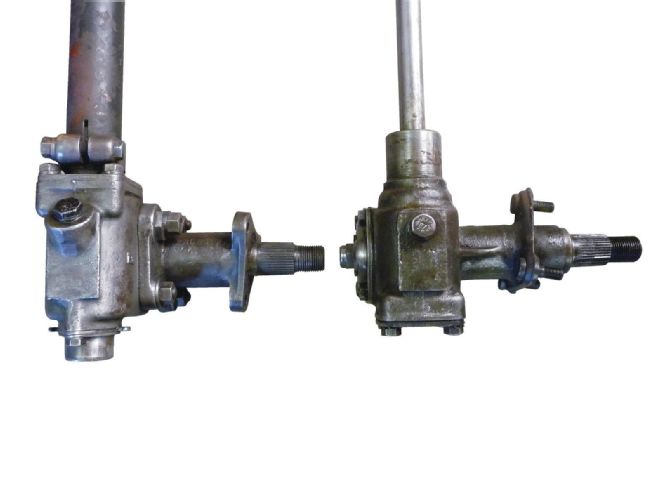 On the left is the unmodified Hudson steering box; the stock ’32 is on the right.
On the left is the unmodified Hudson steering box; the stock ’32 is on the right.
“Although the stock ’32 steering gear could have been retained, I wanted the advantages a rolling sector design steering box offered. A ’53-56 F-100 box would fix the column angle but the larger sector shaft and bulky clamp on the Pitman arm didn’t fit the look I was after. A friend had installed a ’37 Hudson box in his roadster and I liked the fact that a stock ’32 Pitman arm could be used, and after seeing that steering swap mentioned in some early ’50s “little books” I was on the hunt for one of my own. Eventually I had more Hudson steering boxes than I needed, so I agreed to modify one for Geoff Skene.
“As close as the Hudson box is to ’32-34 Ford steering box in appearance there are actually quite a few differences. One is the steering column mast is larger diameter so the first step of the project was to make mandrel that centered on the bearing races. The box could then be chucked in a lathe and turned down to fit an early Ford steering column.
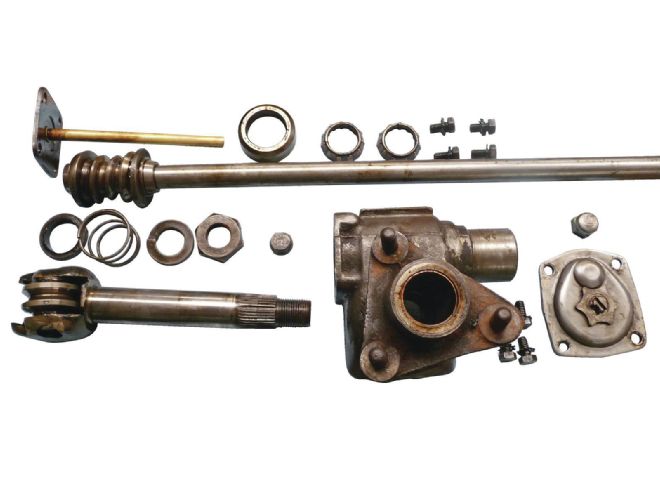 Here are the internals of the Hudson box. Note the roller (arrow) on the sector shaft. It engages with the worm gear on the steering shaft above.
Here are the internals of the Hudson box. Note the roller (arrow) on the sector shaft. It engages with the worm gear on the steering shaft above.
“The next issue to address was the sector seal. The Hudson box used a seal that slipped over the sector shaft and was held in place by a spring behind the Pitman arm. This seemed a little too archaic, so another mandrel was made to machine a step in the sector housing. A steel sleeve that accepts a contemporary lip seal was fabricated then pressed on and welded in place.
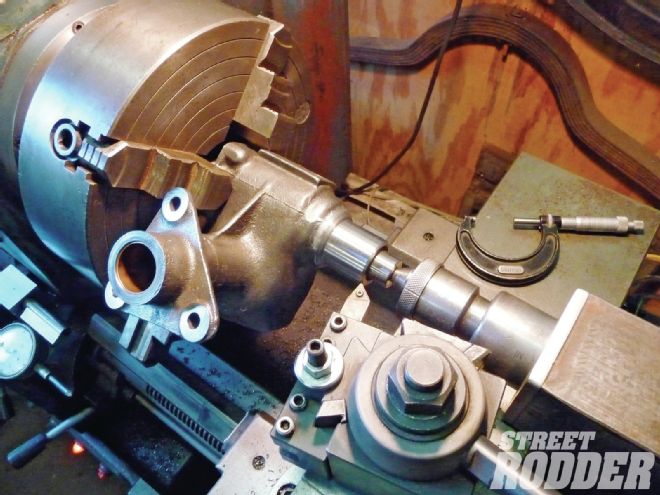 The snout on the Hudson’s gearbox where the mast jacket attaches was turned down to accept the original Ford column.
The snout on the Hudson’s gearbox where the mast jacket attaches was turned down to accept the original Ford column.
“The modified steering box was positioned in a mock-up frame to check the fit of the original Hudson mounting flange. It was reasonably close and by drilling three new holes in the frame and shimming the flange with a couple washers it would work, but that’s not my style. Skene and I talked and decided to machine off the stock Hudson mount and weld on a new ’32 Ford-style flange. A stock ’32 steering gear was installed in the mock-up frame to establish the column’s centerline, then the Hudson steering was put in place, aligned properly, and the new flange was tack-welded to the housing. To avoid weld cracking caused by the dissimilar metals (cast box, steel plate flange), the flange was fillet brazed and ground smooth.
“With the machinework completed on the steering box it was time to address the steering shaft. It was shortened, then I machined a Ford-style taper and threads and milled a keyway. An early Ford column-locking lug was added to work with an original ’32 column drop, lock, and switch.
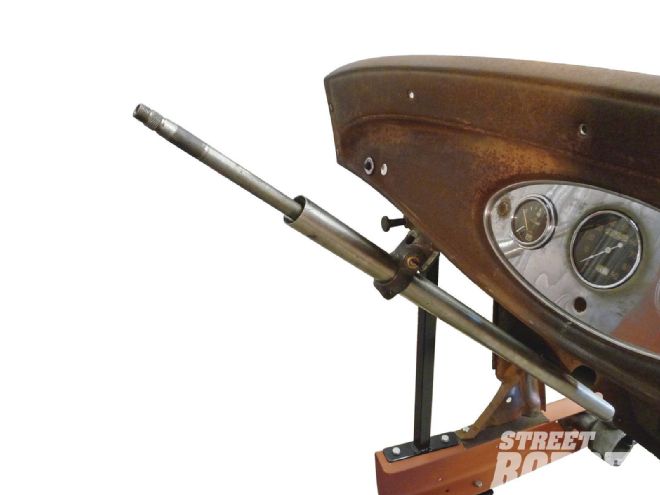 A test-fit indicated the Hudson steering shaft would have to be shortened.
A test-fit indicated the Hudson steering shaft would have to be shortened.
“[Skene] also wanted to be able to use the original ’32-style headlight switch and control rod. The lower cover plate on the steering gear had to be modified with a larger brass tube to allow the light control rod to pass through. I set this up in a fixture to ensure that it was square and then silver soldered it in place. A ’37-39 Ford lower plate could have been used, but finding a good one is becoming more and more difficult. I did use an original ’37-39 Ford light switch bracket and bail, completing the lower end and allowing the use of a stock ’32 light switch.
“Luckily the major internal parts were in good condition, as replacement Hudson sector shafts and worms are nearly impossible to find. The rest of the rebuild involved new bearings, gaskets, new sector bushings honed to fit, and reassembly and final adjustment.
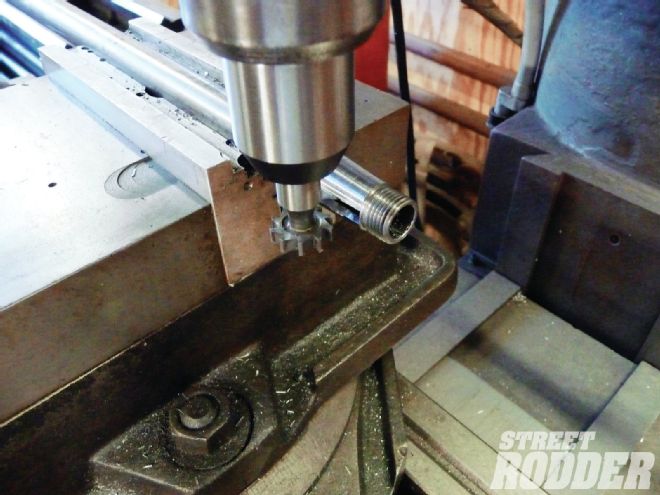 To accept an original Ford wheel the Hudson steering shaft had to be shortened, tapered, threaded, and a keyway cut. The shaft is hollow to accommodate the rod that connects to the light switch.
To accept an original Ford wheel the Hudson steering shaft had to be shortened, tapered, threaded, and a keyway cut. The shaft is hollow to accommodate the rod that connects to the light switch.
“The only other modification necessary to install this in a stock frame is to enlarge the sector shaft hole from 1-1/4 to 1-7/8 inches. With the sector shaft hole so close to the mounting flange holes, I made up a reinforcing plate to bolt onto the outside of the frame. Other than that, it should be a bolt-in and have much the same look as an original ’32 box, just with much easier steering.”